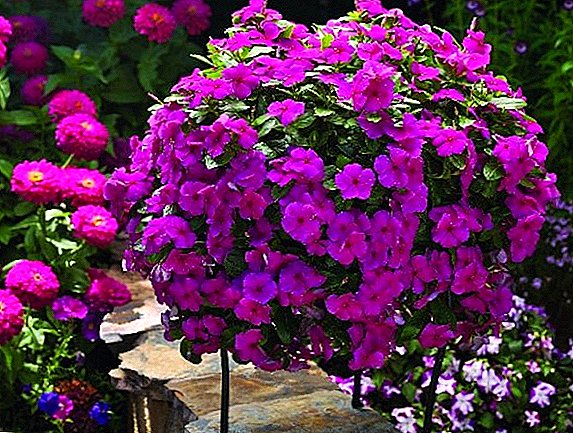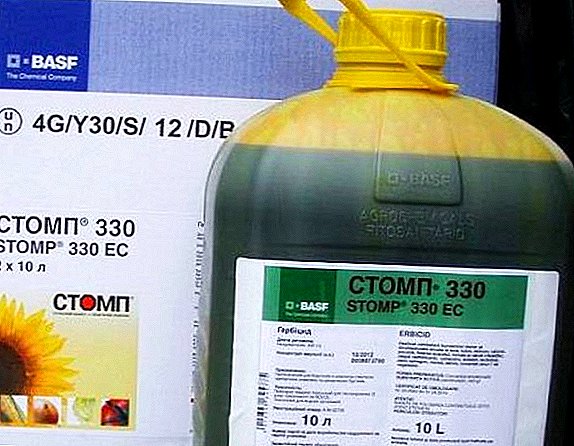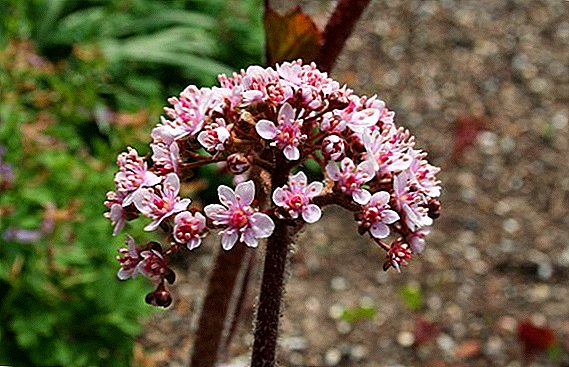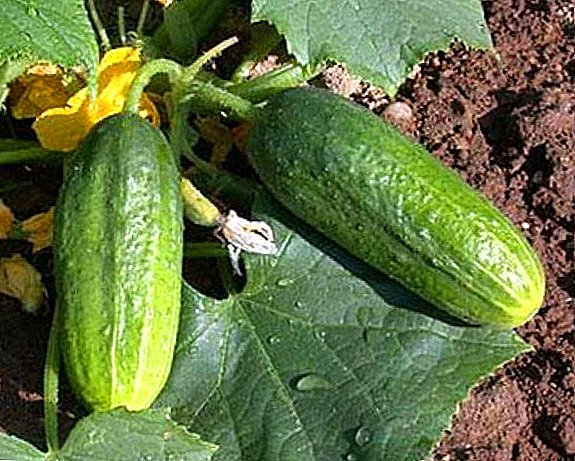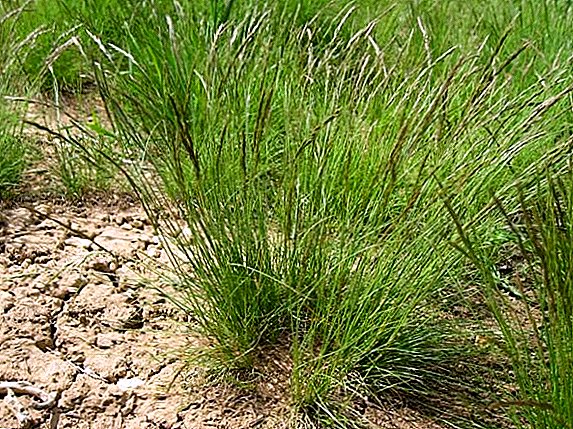 Fescue - cereal perennial plant. The main function of this grass is especially decorative, that is why it is so loved by landscape designers. This is a beautiful, very peculiar and interesting plant. The undeniable advantage of fescue is that it is resistant to diseases and parasites.
Fescue - cereal perennial plant. The main function of this grass is especially decorative, that is why it is so loved by landscape designers. This is a beautiful, very peculiar and interesting plant. The undeniable advantage of fescue is that it is resistant to diseases and parasites.
The genus Fescue has more than 150 species, but we have identified the most popular of them and give their characteristics.
Alpine Fescue
 The root system of this fescue is very thick and developed. In the third year of life, the plant develops into a semi-superhuman, creating a small hillock on the surface. Generative stems reach a length of 70 cm.
The root system of this fescue is very thick and developed. In the third year of life, the plant develops into a semi-superhuman, creating a small hillock on the surface. Generative stems reach a length of 70 cm.
The main deciduous mass falls to a height of 10-30 cm from the ground. Loves light very much. It has high drought tolerance and winter hardiness. Forms a graceful herbage of a gray shade. In the fruiting period alpine fescue should be cut. In landscape design it is recommended to plant the plant in the composition of the Moorish lawns, rabatok, as well as group plantings.
Amethyst fescue

This is a spectacular large plant of intense blue-green color. Amethyst fescue will be a real decoration in the garden. The adult bush forms a dense rounded hummock up to 60 cm high. It blooms beautifully in early summer. Purple flowers rise high on thin stems above the total mass of leaves. They have no decorative value, so they should be cut off in order not to waste the plant. By the age of ten the amethyst fescue forms a large curtain reaching one meter in diameter. It grows well on light, well-drained soils. Does not tolerate stagnation of water and loves sunlight, it acquires on it the depth and richness of color.
Important! It is not recommended to land on nutrient soils and in the shade, as it loses its attractiveness.
It is better to plant the plant in groups of 3-5 copies. In severe frosts, the leaves can become icy, but then quickly return to normal. In the garden looks favorably in the foreground. Can be planted as decoration tracks and alpine slides. It also looks beautiful near the water, against the background of stones and small pebbles. Spectacular in any mixborder, sunny flower garden and rockeries.
Valissa fescue (Tipchak)
 Plant characteristic of steppe zones. Dense sod-shaped perennial shrub with a bluish-green color of the leaves, which gives wax bloom. It has thin stems up to 40 cm high. Leaf blades are thin less than a millimeter and protrude vertically upwards, but significantly shorter than the stem, outside are rough to the touch. The flowering period comes at the end of May - the beginning of June. Valissa fescue sun-loving, prefers dry places and sandy soils. Well tolerates excessive moisture. Can grow in one place up to five years. The fescue fescue is used in gardens as a living carpet, and also goes well with many other vegetation, unobtrusively emphasizing its natural beauty.
Plant characteristic of steppe zones. Dense sod-shaped perennial shrub with a bluish-green color of the leaves, which gives wax bloom. It has thin stems up to 40 cm high. Leaf blades are thin less than a millimeter and protrude vertically upwards, but significantly shorter than the stem, outside are rough to the touch. The flowering period comes at the end of May - the beginning of June. Valissa fescue sun-loving, prefers dry places and sandy soils. Well tolerates excessive moisture. Can grow in one place up to five years. The fescue fescue is used in gardens as a living carpet, and also goes well with many other vegetation, unobtrusively emphasizing its natural beauty.
Did you know? In past centuries, there was a special language of flowers, which was called "villages". With it, people during the giving of certain flowers expressed absolutely any feelings!
Highest fescue
 It grows on brown and gray forest soils, as well as on sod-podzolic soils. The highest fescue is a monoecious plant with leathery scaly leaves at the base. The vagina is split almost to the bottom and rough to the touch. Leaf plates are flat, with no ribs on top. Polycolle panicles with widely spread rough branches. Spikelet scales have a leathery cover. The bottom scales of flowers are rough over the entire surface and have a length of about 6 mm. Anthers in length 3.5 mm. Apical ovary with thick hairiness.
It grows on brown and gray forest soils, as well as on sod-podzolic soils. The highest fescue is a monoecious plant with leathery scaly leaves at the base. The vagina is split almost to the bottom and rough to the touch. Leaf plates are flat, with no ribs on top. Polycolle panicles with widely spread rough branches. Spikelet scales have a leathery cover. The bottom scales of flowers are rough over the entire surface and have a length of about 6 mm. Anthers in length 3.5 mm. Apical ovary with thick hairiness.
Prickly fescue
 It is a low herbaceous plant not more than 15 cm high. Very decorative look because of its thin elastic leaves. It has a silver-green color.
It is a low herbaceous plant not more than 15 cm high. Very decorative look because of its thin elastic leaves. It has a silver-green color.
Red fescue

It is a plant with thin, straight stems about 80 cm long and with almost no foliage. Vegetative shoots densely leafy, green with a reddish tinge. The leaves are narrow, longitudinally folded, up to 40 cm long. The inflorescence is paniculate and friable, 12 cm long, with roughness on the branches. Red fescue is frost-resistant and perfectly tolerates waterlogging, as well as even flooding.
If you are wondering how to sow the country lawn so that it is perfectly smooth, dark green and saturated, this particular type of fescue will suit you. This grassy shrub is as attractive as it is durable. In the first year, grass growth is severely slowed down, but over the next two years a thick green carpet is formed. By the fourth year of life, it matures completely.
Red fescue in landscape design, as the description suggests, plays the role of a first-class lawn. For these purposes, you should choose two forms of plants: rhizomatous-rykhlokustovuyu and ryhlokustovuyu.
Meadow Fescue

This is a herbaceous perennial with a short creeping rhizome. The above-ground part is erect, low-edged, not more than 1.2 m high. The leaves are flat, with a characteristic roughness at the edges and in the upper part. Their width is not more than 5 mm. At the base of the leaf plate there are ears. The average length of the panicle varies from 6 to 20 cm. There is a weak violet flare on the green stripes.
Grass blooms in the summer. Meadow fescue is primarily used to create a lawn. In addition, the plant has a high feed value.
Mayra Fescue
 The native place of growth of this festivity is the Atlas Mountains at an altitude of more than two kilometers. Each bush of Myra forms a beautiful neat hill of flat gray-green foliage up to 60 cm high. Thin and very elegant color panicles flourish in June. This fescue perfectly tolerates heat and stagnation of water. It grows slowly, but the adult bush is very durable. Mayeri planted in flower beds, rabatki, mixborders and curbs.
The native place of growth of this festivity is the Atlas Mountains at an altitude of more than two kilometers. Each bush of Myra forms a beautiful neat hill of flat gray-green foliage up to 60 cm high. Thin and very elegant color panicles flourish in June. This fescue perfectly tolerates heat and stagnation of water. It grows slowly, but the adult bush is very durable. Mayeri planted in flower beds, rabatki, mixborders and curbs.
Did you know? The fact that plants react to humans like living things has been proven. An experiment was conducted in which one person broke off the petals of a flower, and the second was courting him with special care. With the help of special devices was recorded a different reaction to two people.
Pancake fescue
 Homeland perennial - the Pyrenees. This is a very low plant - up to 15 cm in height with spikelets. The leaves are bright and elegant, up to 8 cm in height. It blooms in June, and the seeds are ready by July. After 2-3 years of growth, paniculate fescue forms large cushion thickets. Perfectly grows under the sun, but also does not hesitate a little shaded sites.
Homeland perennial - the Pyrenees. This is a very low plant - up to 15 cm in height with spikelets. The leaves are bright and elegant, up to 8 cm in height. It blooms in June, and the seeds are ready by July. After 2-3 years of growth, paniculate fescue forms large cushion thickets. Perfectly grows under the sun, but also does not hesitate a little shaded sites.
Reproduces the division of adult plants in early autumn or spring. After winter, many leaves die off and need to be removed in early spring. They quickly regain their growth even at relatively low temperatures. Ideal for rockeries.
Sheep fescue

In nature, it grows in Ukraine and Western Europe. A loose-grained plant with thin, triangular upward stems. The leaves are sinuous, long, thin and bristle. The whisk is elongated, loose, with declined branches. Spikelets of a light green shade.
It is used on curbs and large flower beds, paths and near water. Sowing a lawn is the vocation of a sheep fescue. It grows well on dry, sandy and lean soils. With their fertilizer forms a dense grass carpet, which firmly and deeply penetrates deep into the soil. Successfully applied on dry slopes. Due to its low growth, it is successfully used on dry slopes. Sheep fescue tolerates heavy trampling and mowing up to 3.5 cm. It grows well in partial shade and under pine trees. On dry sandy soils, red fescue becomes her partner. They make an extraordinary natural carpet with the effect of a certain gradient.
Squat fescue

The smallest representative of fescue with small katinkami. It has short narrow leaves, but the plant looks gracefully and spectacularly among the stones. Toward the end of the summer, it branches out with panicles of small flowers. Until late autumn, you can admire the silvery bluish inflorescences of the squat fescue. It propagates by division and seeds.
Siberian Fescue
 The plant grows in nature in Siberia, Manchuria and Mongolia on slopes, rocks and sometimes on the sands. Siberian Fescue is a dioecious plant with light gray shoots. Panicle mildly sparse with rough branches. Spikelet scales are almost completely webbed and markedly different from lower scales. The latter are uniformly covered outside with small spikes and pointed to the top. Ovary on top dense and hairy. The kernels are free, grooved from the ventral side, with a long linear seed scar.
The plant grows in nature in Siberia, Manchuria and Mongolia on slopes, rocks and sometimes on the sands. Siberian Fescue is a dioecious plant with light gray shoots. Panicle mildly sparse with rough branches. Spikelet scales are almost completely webbed and markedly different from lower scales. The latter are uniformly covered outside with small spikes and pointed to the top. Ovary on top dense and hairy. The kernels are free, grooved from the ventral side, with a long linear seed scar.
Gray Fescue (Calle)
 The plant’s homeland is Eastern and Central Europe, the Baltic States, Western Ukraine, the Urals and the Caucasus. This is a low perennial grass with blue-gray leaves. Forms semicircular lush curtains up to 60 cm high. The leaves are narrow, linear iridescent from gray-green to steel blue. After flowering inflorescences become light brown. The flowering period in June and July. Planted gray or blue fescue on dry ground or heather. She brings revival in the composition of the plots. It is a heat-loving shrub, it grows mainly in sandy-humus soils with good drainage and insight. Sun-loving. It carries lime in the soil. After 4 years, the plant must be divided. To color the leaves was the most saturated, the leaves need to be transplanted every two years. In the cold years, the blue-light fescue strongly tarnishes. Usually used as a ground cover material, but keeping the fescue looking good and in one shape is quite difficult. Looks great on alpine slides and grows on poor and dry soils.
The plant’s homeland is Eastern and Central Europe, the Baltic States, Western Ukraine, the Urals and the Caucasus. This is a low perennial grass with blue-gray leaves. Forms semicircular lush curtains up to 60 cm high. The leaves are narrow, linear iridescent from gray-green to steel blue. After flowering inflorescences become light brown. The flowering period in June and July. Planted gray or blue fescue on dry ground or heather. She brings revival in the composition of the plots. It is a heat-loving shrub, it grows mainly in sandy-humus soils with good drainage and insight. Sun-loving. It carries lime in the soil. After 4 years, the plant must be divided. To color the leaves was the most saturated, the leaves need to be transplanted every two years. In the cold years, the blue-light fescue strongly tarnishes. Usually used as a ground cover material, but keeping the fescue looking good and in one shape is quite difficult. Looks great on alpine slides and grows on poor and dry soils.
Calle fescue is rich in its varietal variety. Varieties differ in color diversity, sometimes this difference is almost imperceptible. Some of them are more bluish, others are more silvery. Differ also in height.
Did you know? Flowers have a peculiar ability of orientation in time. In 1720, Carl Linnaeus created the world's first floral clock in a small town in Switzerland.







